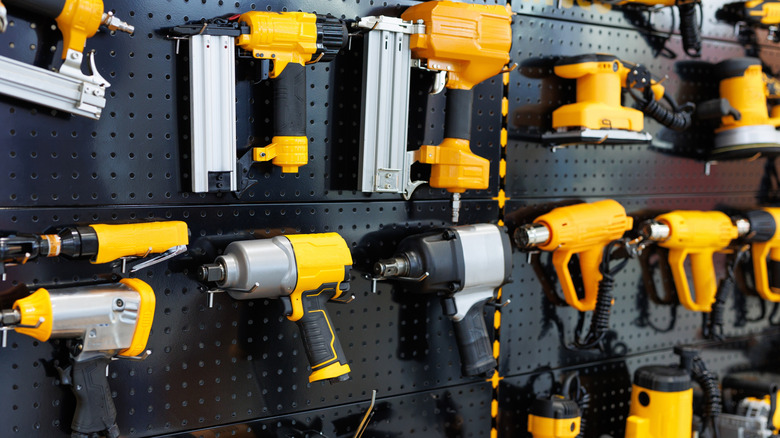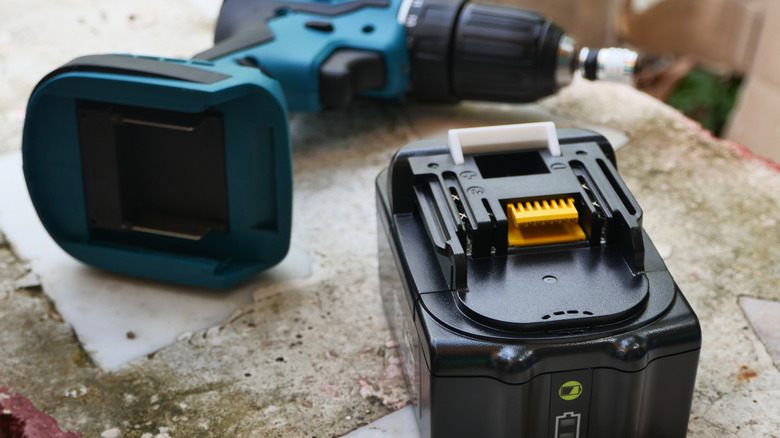Is Power Tool Battery Standardization Real? Here's What You Need To Know
Anyone who depends on power tools for their livelihood or hobbies knows the struggle of a mixed toolbox. With most power tool companies like Ryobi, Stanley Black & Decker, and Milwaukee utilizing their own proprietary charging systems, nothing is more frustrating during a DIY project than sifting through a cluttered toolshed to find the correct charger. Power tool battery standardization reentered the political discourse in 2025 when a series of posts and articles reported that the U.S. Department of Government Efficiency, then run by billionaire Elon Musk, had initiated a "one battery to rule them all" mandate. Although merely an April Fool's joke, tool enthusiasts buzzed about a single, standardized battery system.
Standardization advocates have long noted the anti-competitive nature of manufacturers' battery designs, which lock users into their respective ecosystems, disincentivize competition, and fashion barriers to entry for smaller and upstart tool companies. And while some manufacturers have fashioned themselves a niche in the market by making affordable tools compatible with more expensive brands' batteries, the majority of consumers are left with two options: sticking exclusively with a single brand or dealing with the frustration of working with multiple charging systems.
In either case, consumers shoulder the brunt of a system designed to negate cross-compatibility, with some even braving the dangers of refurbishing their old lithium-ion batteries. And while tech companies like Apple have come under legislative fire for anti-competitive charging systems, best exemplified by the EU's compulsory charging port standards, power tools have largely escaped this scrutiny. This discrepancy has prompted many to wonder how battery standardization might benefit the power tool market for consumers and manufacturers alike.
Defining the problem
Cordless power tools typically depend on lithium-ion batteries. Small, lightweight, and efficient, these batteries charge quickly, offer long run times, and don't quickly degrade in quality . Other battery types include nickel-cadmium (NiCd) and nickel-metal hydride (NiMH). However, these have fallen out of favor due to shorter lifespans and memory effect degradation, in which partial charges reduce their overall charging capability. Although NiMH batteries can still be found in many mid-range cordless models, most power tools depend on lithium-ion technologies. Within this category, batteries are further divided by voltage type, typically ranging from four to thirty-six volts, with the most common supplying 18 volts.
The power tool industry lacks a standard battery type for several reasons. In addition to voltage and amperage differences, manufacturers utilize different communication protocols to manage the power delivery system, in which electronic chips monitor temperature, charge level, and power flow, presenting major interchangeability hurdles. Another standardization roadblock is the differing physical designs of power tool batteries, which rely on a series of connection points, including rails, electrical contacts, and locking mechanisms, to secure battery placement. Poor compatibility issues could cause electrical malfunctions or overheating, endangering users and complicating warranty guarantees.
Some note that the most likely driving force behind the void of a universal battery is a lack of will, rather than an inability. From a financial perspective, large manufacturers are disincentivized from designing interchangeable battery systems, as proprietary designs ensure brand loyalty. It also gives manufacturers access to the replacement battery market, where companies see nearly double the profit margin compared to tool sales.
Creating a standard battery
Although difficult, battery standardization isn't impossible. To move towards a universal battery, several corporate and governmental stakeholders across the power tool industry will need to collaborate on several challenges. For instance, manufacturers need to coordinate designs, collaborating on cross-compatible communication protocols, power ports, contacts, and electrical circuits to ensure mutually beneficial safety and performance metrics. As an industry, power tool suppliers have consistently proven that single charging systems can be applied to various tools, with brands like Ryobi, Makita, and Bosch offering their customers batteries that are compatible with hundreds of products.
Government regulators would also need to play a major role. Already, governing bodies like the Department of Energy and EPA have initiated assessments of new efficiency and safety standards for lithium-ion batteries, while the Department of Defense has invested millions in developing a "Family of Advanced Standard Batteries," showcasing how government actors can coordinate technical standards without diminishing competition or performance.
As mentioned, consumers and manufacturers alike could benefit from battery standardization. For consumers, a standard battery would save them money, time, and energy while providing more purchasing flexibility, reducing energy expenditure, and minimizing battery waste. For manufacturers, standardization could eliminate redundant production, simplify supply chains, and reduce manufacturing costs, while eliminating barriers to entry and increasing competition. Despite these benefits, some are skeptical about implementing battery standardization. For one thing, manufacturers will likely resist scrapping proprietary designs for universal chargers. Meanwhile, performance concerns have some consumers hesitant to endorse the standard. Whether the industry can overcome these challenges will likely determine the future of battery standardization initiatives.


